Environmental Law
-
- The Legal Consequences of 46 CFR Subchapter “M” Maritime Reporter, Nov 2014 #20
As the holiday season and the end of another year quickly approaches, the towing industry patiently waits for the Coast Guard to finalize the long-awaited towing vessel inspection rule. More than 10 years ago, Congress passed the Coast Guard and Maritime Transportation Act of 2004, requiring more stringent regulation of uninspected towing vessels (UTVs).
Since that time, the Coast Guard and several industry groups (including the Towing Safety Advisory Committee (TSAC), American Waterways Operators (AWO) and the American Bureau of Shipping) have been working hard to finalize the rulemaking and attendant regulations. The stated intent of the rulemaking is to promote safer work practices and reduce casualties on towing vessels by requiring that vessels adhere to prescribed safety standards and safety management systems or to an alternative, annual Coast Guard inspection regime.
As the Coast Guard finalizes its adjudication of the 3,000 comments received in response to the notice of proposed rulemaking in 2011, let’s take this opportunity to consider the obvious and not so obvious legal consequences of such a significant rule.
Obvious Consequences
Civil Penalties
Violations of proscribed safety standards will result in the assessment and collection of civil monetary penalties. The Coast Guard employs Hearing Officers to adjudicate civil penalty cases in support of the Marine Safety mission. In turn, 46 USC §2107 requires standard procedures for the handling of civil penalties for infractions of regulations but an “on the record” hearing within the meaning of the Administrative Procedures Act (APA) is not required. It is yet to be determined whether Coast Guard enforcement activity for towing vessels will be phased in a manner similar to the ballast water standards. Readers will recall that the Coast Guard did not immediately enforce the ballast water management regulations in 2013. Furthermore, it is important to note that the proposed rulemaking sets forth a phased-in scheme, providing a fairly generous timeframe for compliance.
Suspension & Revocation
In the aftermath of marine casualties, Coast Guard Investigating Officers are charged with ascertaining whether credentialed mariners committed acts of misconduct, incompetence, negligence or violations of law. Notably, 46 CFR §5.27 provides that “Misconduct is human behavior which violates some formal, duly established rule. Such rules are found in, among other places, statutes, regulations, the common law, the general maritime law, a ship’s regulation or order, or shipping articles and similar sources.” The impending towing vessel regulations will provide casualty investigators with some additional bases to craft suspension and revocation charges against credentialed mariners.
Not So Obvious
Consequences
Limitation of Liability
Running a vessel or fleet of towing vessels is a risky business and limitation of liability is an important component of maritime law. In short, limitation of liability in the United States permits vessel owners and their insurers to reduce the amount of the potential exposure to the value of the vessel and pending freight. The owner is entitled to limitation if it can establish that the acts or omissions leading to the casualty were not within its “privity or knowledge.” Determining whether an owner can limit its liability can hinge upon an analysis of whether any applicable safety regulation was violated. Given this established legal framework, violation of a regulation in the impending Subchapter “M” could form the basis for denying an owner’s limitation application. As the publication of Subchapter “M” will put vessel interests on notice of the standards necessary to safely operate towing vessels, owners and operators are encouraged to participate in the Coast Guard’s Towing Vessel Bridging Program (TVBP) to ensure they are better informed and prepared to meet the impending requirements in the coming years.
Negligence Per Se
Non-compliance with a Coast Guard regulation “opens the door” for a charge of negligence per se, which is negligence established as a matter of law. In these instances, the breach of the duty is not a jury question. More importantly, a breach of a safety regulation, if proven, could prevent a court from considering the comparative fault of an injured crewmember in a Jones Act lawsuit. Contemplate that an employee is arguably 75% responsible for his own injury but the vessel owner is nonetheless held 100% responsible with no offset because there was a violation of some Subchapter M regulation. Historically, attorneys representing injured seaman often looked to OSHA regulations to establish negligence per se. Now Coast Guard regulations will provide an additional basis in support of injured crewmembers’ claims of legal negligence.
Pollution Claims
Under the Oil Pollution Act of 1990, Responsible Parties (RPs) can submit reimbursement claims to the National Pollutions Funds Center (NPFC) for removal costs and damages. RPs may limit their liability if costs and damages incurred exceed the amount of total liability as determined by 33 U.S.C. §2702. However, RPs cannot limit their liabilities if the incident was proximately caused by the violation of an applicable federal safety, construction, or operating regulation by an RP. The NPFC has previously denied reimbursement claims on the basis that applicable safety and operating regulations were violated.
Conclusion
When finalized, the Subchapter “M” Rulemaking will promote safer work practices and should reduce casualties throughout the towing industry. This is what Congress and the Coast Guard intended. As the final rule is published, vessel interests are encouraged to consider the lesser intended and not so obvious consequences of such a significant rulemaking. In the coming year, owners and operators of towing vessels should proceed diligently with “eyes wide open.”
The Author
Daniel J. Fitzgerald, Partner at Freehill Hogan & Maher LLP, concentrates his practice in maritime, international, and environmental law in various U.S. and foreign jurisdictions.
t: 212-381-3047
e: [email protected]
-
- Could Offshore Crewing Requirements Make Things Worse? Maritime Reporter, Nov 2016 #16
and chair of the maritime and international trade practice at Blank Rome LLP. Waldron concentrates his practice in maritime, international, and environmental law, including maritime security. He served in the U.S. Coast Guard for 20 years, attaining the rank of commander, and was senior counsel to the
-
- U.S. Flag Vessel Safety Maritime Reporter, Nov 2018 #12
future.About the AuthorsJon Waldron is a partner in the Firm’s Washington, D.C., office who concentrates his practice in maritime, international and environmental law, including maritime security. He served in the U.S. Coast Guard for 20 years, attaining the rank of commander, and was senior counsel to the
-
- Regulatory Crewing Challenges for Offshore Wind Vessels Maritime Reporter, Jul 2019 #14
AuthorJonathan K. Waldron is a partner in the Blank Rome's Washington, D.C., office who concentrates his practice in maritime, international and environmental law, including maritime security. He served in the U.S. Coast Guard for 20 years, attaining the rank of commander, and was senior counsel to the
-
- Key Salvage Issues for 2013 – and Beyond… Marine News, Apr 2013 #20
remains a work in progress. Jonathan Waldron is Chairman of the ASA Legal Committee. He concentrates his practice in maritime, international, and environmental law, including maritime security. Mr. Waldron is a visiting professor at the Massachusetts Maritime Academy where he teaches on legal issues related
-
- Marine Casualty Reports – Clarified Maritime Reporter, Mar 2014 #16
to make a marine casualty report. The Author Jonathan Waldron, partner at Blank Rome, concentrates his practice in maritime, international and environmental law, including maritime security. t: +1 (202) 772-5964 e: [email protected] (As published in the March 2014 edition of Maritime Reporter
-
- Will Congress Pass Any Maritime Legislation in 2014? Maritime Reporter, Nov 2014 #26
try again next year.” The Author Jonathan K. Waldron, partner at Blank Rome, concentrates his practice in maritime, international, and environmental law, including maritime security. Mr. Waldron served in the U.S. Coast Guard for 20 years, and is recognized as a leader in shipping law. Mr. Waldron
-
- Insights: Steven Candito, President & CEO, NRC Marine News, Mar 2015 #12
on vessel owner and insurance matters. Candito was previously an attorney with Haight Gardner Poor & Havens, specializing in maritime litigation and environmental law. He also served as a marine engineer aboard Exxon USA’s domestic tanker fleet from 1980 to 1985. Candito is a graduate of Hofstra University
-
- INSIGHTS: Steve Candito, President, Foresea Consulting Maritime Logistics Professional, Q2 2016 #12
focus on vessel owner and insurance matters. Before that, Candito was an attorney with Haight Gardner Poor & Havens, specializing in maritime and environmental law. Candito has also served as a marine engineer aboard Exxon USA’s domestic tanker fleet. He is a graduate of Hofstra University School of Law
-
 )
March 2024 - Marine Technology Reporter page: 30
)
March 2024 - Marine Technology Reporter page: 30es the necott. “The focus since then has been on scaling while en- wave, current and vessel motions that in? uence loads in the suring the lightest environmental impact,” says The Metals power umbilical. The LARS can operate in up to 3.5m wave Company CEO Gerard Barron. In-? eld collection system tri- height
-
 )
March 2024 - Marine Technology Reporter page: 25
)
March 2024 - Marine Technology Reporter page: 25Portable System Requires only UK, Maxlimer mapped the shape of the Wavelet 2KW at 250ms Ping Rate CorrelaO on > 0.96 caldera and measured the environmental conditions of water above it. Sensors on board collected additional data, explained SEA-KIT Operations Director Ash Skett, including bathymetric
-
 )
March 2024 - Marine Technology Reporter page: 17
)
March 2024 - Marine Technology Reporter page: 17. The choice of method depends on factors like the struc- curate calculations of anode currents to assess remaining life, ture’s location, depth, environmental conditions, and the spe- nor determine issues with current drain to or from adjacent ci? c requirements of the maintenance plan. structures
-
 )
March 2024 - Marine Technology Reporter page: 14
)
March 2024 - Marine Technology Reporter page: 14, which users can choose to activate for a sprint al new use cases for the glider community. With an increased speed of up to 3 knots. need for environmental monitoring, especially to track the “The Sentinel is the world’s fastest glider – its buoyancy impact of offshore construction on the ocean ecosystem
-
 )
March 2024 - Marine Technology Reporter page: 13
)
March 2024 - Marine Technology Reporter page: 13signi? cantly grown, alongside the increasing number of use cases for which gliders provide a practical solution. Ocean monitoring – whether for environmental assessments, mammal monitoring, ? sheries, physical oceanography, defense, or dozens of other missions – has driven advance- ments in glider
-
 )
March 2024 - Marine Technology Reporter page: 6
)
March 2024 - Marine Technology Reporter page: 6Journal of Diving History and the MTR. Authors & Contributors Konowe Quinn Konowe Celia Konowe is from Reston, Va., and has a bachelor’s degree in environmental studies. She has study abroad experience in France and Ecuador. Currently, she is pursuing her master of environmental studies degree at Dalhousie
-
 )
April 2024 - Maritime Reporter and Engineering News page: 35
)
April 2024 - Maritime Reporter and Engineering News page: 35training of offshore professionals at Equinor. The tai- learning methods, because they mimic the way people live lored con? guration will enable environmental conservation today,” says Chawla. The gami? cation of learning makes it drills, oil spill detection and recovery simulations and all-en- fun
-
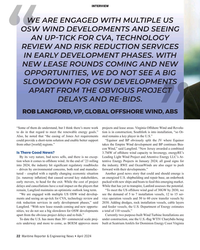 )
April 2024 - Maritime Reporter and Engineering News page: 22
)
April 2024 - Maritime Reporter and Engineering News page: 22good signs for into 2024, the industry hit signi? cant regulatory roadblocks the industry. RWE and OceanWinds are also eager to push – driven by environmental concerns, both real and manufac- forward with their developments.” tured – coupled with a rapidly changing economic situation Another good news
-
 )
April 2024 - Maritime Reporter and Engineering News page: 21
)
April 2024 - Maritime Reporter and Engineering News page: 21offshore wind business will grow year-on-year.” developments and another stint at SBM, which entailed proj- While there are plentiful regulatory and environmental hur- ect work globally. dles, they are not alone. About ? ve years ago he made the switch over to offshore “One of the main risks I see is the
-
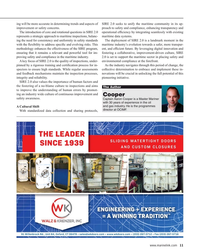 )
April 2024 - Maritime Reporter and Engineering News page: 11
)
April 2024 - Maritime Reporter and Engineering News page: 11the maritime industry. 2.0 is set to support the maritime sector in placing safety and A key focus of SIRE 2.0 is the quality of inspections, under- environmental compliance at the forefront. pinned by a rigorous training and certi? cation process for in- As the industry navigates through this period of
-
 )
April 2024 - Maritime Reporter and Engineering News page: 10
)
April 2024 - Maritime Reporter and Engineering News page: 10inspection framework. tablished inspection practices to elevate maritime safety and SIRE 2.0 brings digital reporting and real-time analytics, to environmental responsibility to unprecedented levels. the fore, marking a signi? cant technological stride. These in- SIRE 2.0 represents an update and a
-
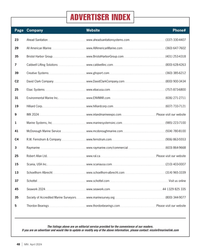 )
April 2024 - Marine News page: 48
)
April 2024 - Marine News page: 48www.ghsport.com (360) 385-6212 C2 David Clark Company www.DavidClarkCompany.com (800) 900-3434 25 Ebac Systems www.ebacusa.com (757) 873-6800 31 Environmental Marine Inc. www.ENVMAR.com (606) 271-2711 19 Hilliard Corp. www.hilliardcorp.com (607) 733-7121 9 IMX 2024 www.inlandmarineexpo.com Please
-
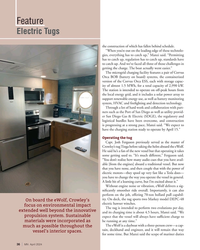 )
April 2024 - Marine News page: 36
)
April 2024 - Marine News page: 3670-ton bollard pull capabil- ity. On deck, the tug sports two Markey model DEPC-48 On board the eWolf, Crowley’s electric hawser winches. focus on environmental impact The tug is intended to perform two evolutions per day, extended well beyond the innovative and its charging time is about 4.5 hours,
-
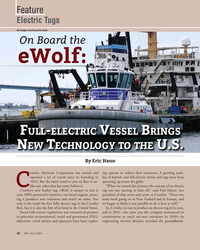 )
April 2024 - Marine News page: 32
)
April 2024 - Marine News page: 32electric tug of its own, Faced with stricter regulations and commercial pressure and in 2021—the same year the company announced its to prioritize environmental, social and governance (ESG) commitment to reach net-zero emissions by 2050—its objectives, vessel owners and operators have been explor- engineering
-
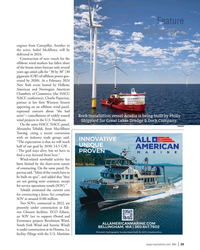 )
April 2024 - Marine News page: 29
)
April 2024 - Marine News page: 29engines from Caterpillar. Another in the series, Isabel McAllister, will be delivered in 2024. Construction of new vessels for the offshore wind markets has fallen short of the boom times forecast only several years ago amid calls for “30 by 30” (30 gigawatts (GW) of offshore power gen- erated by
-
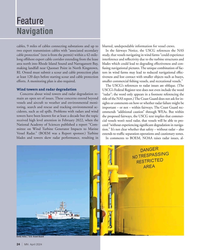 )
April 2024 - Marine News page: 24
)
April 2024 - Marine News page: 24an open set of issues. These concerns extend beyond title of the NAS report.) The Coast Guard does not ask for in- vessels and aircraft to weather and environmental moni- sights or comments on how or whether radar failure might be toring, search and rescue and tracking environmental ac- important – or not
-
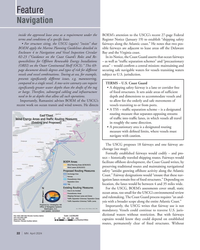 )
April 2024 - Marine News page: 22
)
April 2024 - Marine News page: 22location, the lanes would be between 4 and 35 miles wide. For the USCG, BOEM’s assessments cover small, static ocean areas, too small for the USCG’s environmental review and rulemaking. The Coast Guard process requires “an anal- ysis with a broader scope along the entire Atlantic Coast.” Importantly, the
-
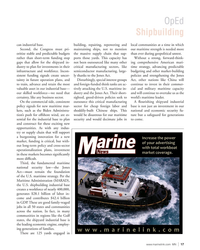 )
April 2024 - Marine News page: 17
)
April 2024 - Marine News page: 17OpEd Shipbuilding can industrial base. building, repairing, repowering and local communities at a time in which Second, the Congress must pri- maintaining ships, not to mention our maritime strength is needed more oritize stable and predictable budgets the massive supply chain that sup- than ever
-
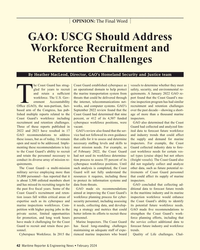 )
February 2024 - Maritime Reporter and Engineering News page: 42
)
February 2024 - Maritime Reporter and Engineering News page: 42cyberspace as vessels to determine whether they meet gled for years to recruit an operational domain to help protect safety, security, and environmental re- and retain a suf? cient the marine transportation system from quirements. A January 2022 GAO re- workforce. The U.S. Gov- threats that could
-
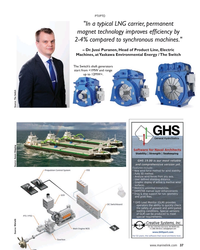 )
February 2024 - Maritime Reporter and Engineering News page: 37
)
February 2024 - Maritime Reporter and Engineering News page: 37technology improves ef? ciency by 2-4% compared to synchronous machines." – Dr. Jussi Puranen, Head of Product Line, Electric Machines, at Yaskawa Environmental Energy / The Switch The Switch’s shaft generators start from <1MW and range up to 12MW+. Source: Wärtsilä Source: Aasen Shipping Source: The
-
 )
February 2024 - Maritime Reporter and Engineering News page: 36
)
February 2024 - Maritime Reporter and Engineering News page: 36compared to the synchronous machines that were commonly used in the past, says Dr Jussi Puranen, Head of Product Line, Electric Machines, at Yaskawa Environmental one once you have a variable speed shaft generator speci? ed,” Energy / The Switch. This adds up to several million dollars in says Christensen
-
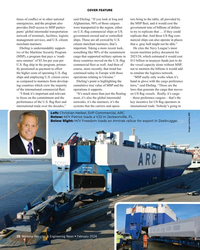 )
February 2024 - Maritime Reporter and Engineering News page: 28
)
February 2024 - Maritime Reporter and Engineering News page: 28COVER FEATURE times of con? ict or in other national said Ebeling. “If you look at Iraq and tors bring to the table, all provided by emergencies, and the program also Afghanistan, 98% of those cargoes the MSP ? eet, and it would cost the provides DoD access to MSP partici- were transported to the
-
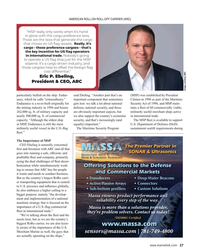 )
February 2024 - Maritime Reporter and Engineering News page: 27
)
February 2024 - Maritime Reporter and Engineering News page: 27AMERICAN ROLL-ON ROLL-OFF CARRIER (ARC) “MSP really only works when it’s hand in glove with the cargo preference laws. Those are the laws that generate the cargo that moves on US ? ag vessels. Really, it’s cargo – those preference cargoes – that’s the key incentive for US ? ag operators in internatio
-
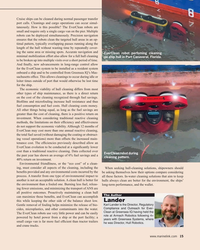 )
February 2024 - Maritime Reporter and Engineering News page: 15
)
February 2024 - Maritime Reporter and Engineering News page: 15. Data collected over EverClean robot during the past year has shown an average of 6% fuel savings and a cleaning pattern. 40% return on investment. Environmental friendliness, or the “eco cost” of a clean- ing, must consider all aspects of the cleaning, including the When seeking hull-cleaning solutions
